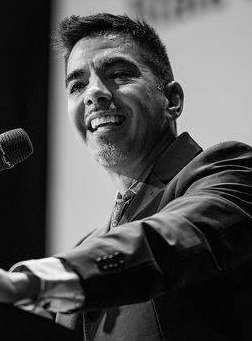Meet the Moment: Bridging the Gap Between Rhetoric and Action
Thank you, Dwayne, Marcus, Cathy, Dimple and Ed, for your thoughtful and inspiring answers to questions that challenge our thinking! Ed, I appreciate the hand off, and the question: How do we bridge the gap that often exists between rhetoric and action within our institutions?
I believe we can bridge the gap by living our purpose. Why does philanthropy exist? Why is it necessary? Let's start here and move toward answering the question more directly.
Philanthropy's purpose is to improve the well-being of humankind – this is spelled out clearly by the word itself, which translates to “love of humankind” from its Greek origins. Our focus should be on preventing and solving social problems. Contrast this with charity, which focuses on eliminating suffering caused by social problems; both are important, but philanthropy seeks to address the causes of suffering – treating the disease, not the symptoms.
Why does this distinction matter? It matters because 1 in 6 children in America live in poverty. In 2018, that meant nearly 12 million children in our country are experiencing food insecurity, toxic stress and opportunity gaps that threaten to have cascading effects for the rest of their lives.
Children do not have many opportunities to engage in civic actions that can lead to political changes that would improve their circumstances – and the parents of children in poverty, already rightly focused on survival, are poorly represented in policymaking as well. These children, and their families, need powerful and responsible voices speaking on their behalf, advocating for them.
Philanthropy can be this powerful voice. Motivated by a love of humankind, we exist to solve social problems. This means investing in closing opportunity gaps – and not only through grants and other financial capital which, after all, is relatively small compared to the business sector and the federal government. However, our social, moral, intellectual and reputational capital is immense – these give us a seat at the table and a voice that others will listen to. We should use this privilege on behalf of those who cannot be there and, all too often, are not offered a seat at all.
When we speak, however, we must be able to do so with authenticity, sincerity and the wisdom of lived experiences – without these, we have no credibility. This is where living our purpose, and bridging the gap between rhetoric and actions, is most critical.
I believe there are five critical ways for philanthropy to do this:
1. Learn About, Understand and Listen to the Community
Bryan Stevenson, the founder of the Equal Justice Initiative, tells us to “get proximate” to the problems we seek to address. Our job is not to make grants and hope for the best or to hand down rules and requirements under the assumption we know what is best. Our job, and our responsibility, is to be on the ground, establish strong connections with community leaders and organizations, listen to them and use that invaluable information to determine where we can be most effective. Then, we must continue to maintain and cultivate these relationships as part of our evaluation process – establishing strong and trusted feedback loops that provide invaluable qualitative data.
2. Demonstrate Courageous Leadership
At our Annual Meeting in November, Wes Moore – the former CEO of the Robin Hood Foundation – told attendees that the generational challenges our country faces today are “an opportunity to actually be bold” and “an opportunity for us to go out and fail and then tomorrow fail a little bit better.” Being bold when there is a significant – even likely – chance of failure is the definition of courageous leadership, a concept at the core of Philanthropy Southeast’s own strategic direction. We have this luxury because we do not have to worry about the next quarterly earnings report or the next election. We are society’s risk capital and should behave accordingly.
3. Solve Problems Through Public/Private Partnerships and Collaboration
Sometimes, to move forward, we have to step out together. One of the key trends we saw in our members’ response to the challenges of the past two years was unprecedented levels of partnership and collaboration. We strive to connect our members with each other, with foundations outside our region, and with experts in the field to learn, grown, and adapt, all because we recognize that philanthropy itself possesses limited financial resources to achieve the kind of change that needs to happen in our country. However, our collective power to educate and advocate for change goes far beyond.
4. Use Every Form of Capital at Our Disposal to Advocate on Behalf of Children, Families and Communities
In 2004, James Joseph – the former president and CEO of the Council on Foundations who also served as U.S. ambassador to post-apartheid South Africa – outlined the five forms of capital available to philanthropy: social, moral, intellectual, reputational and financial, or SMIRF. No other sector of society enjoys this combination of assets, and we must not be afraid to accumulate each of them by building relationships within the community, adhering to principles and best practices, and investing in data and research. Equally important, we must not be afraid to spend each of these effectively to command the attention of policymakers, fuel research that reveals uncomfortable truths, bring unlikely allies together for a common cause and more.
5. Identify Clear Outcomes and Accountability Measures
We do ourselves no favors when we create vague goals or set the bar low – large-scale progress is only possible by setting well-defined, desired outcomes based on what is required to truly move the needle on indicators of poverty, economic mobility and prosperity. Even if we do not achieve these outcomes, we will be left with objective results that provide more data to inform future efforts.
This is a core component of accountability, but not the only one. We must also hold ourselves accountable for changing both the culture of our own institutions and the broader culture of philanthropy. Internally, that means assessing not just individual performance but the living culture of the organization. Externally, we must assess our impact in new ways. As a membership association, we have started looking beyond our own traditional metrics – member recruitment and retention – to assess the impact of our organization on the work of our members. Are we helping our members transform their philanthropic practices?
Lastly, philanthropy must be open to holding ourselves accountable to those we serve – the organizations and communities that we exist to support and preserve. We must approach our work with humility and know that our impact is negligible without the efforts of millions of organizations and individuals working on the ground every day to improve outcomes in their communities.
These five steps all require humility, honesty and hard work – and they are all essential if we are to live out the lofty aspirations of our vision and mission statements. But I firmly believe if philanthropy can do these things, it will create a positive feedback loop that will enable us to make an even greater impact and bring prosperity to more children, families and communities.




